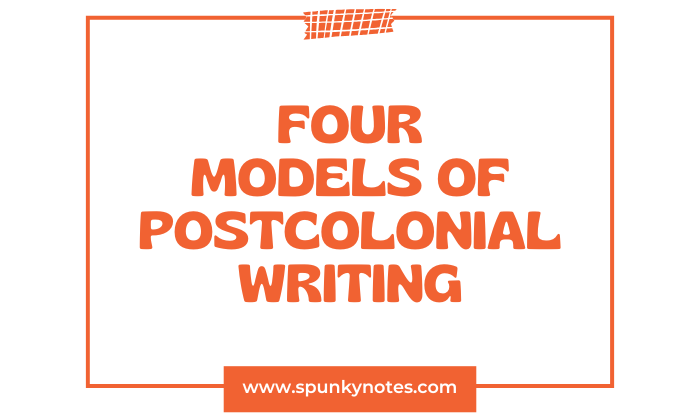

Estimated Reading Time: 10 min
Q. What are the four models of postcolonial writing discussed in The Empire Writes Back?
Post-colonial writing examines the impact of colonization on language, culture, and identity. It explores how colonized societies use literature to reclaim their voices and express their unique experiences.
In The Empire Writes Back, Bill Ashcroft, Gareth Griffiths, and Helen Tiffin outline four key models of post-colonial writing.
Four Models of Postcolonial Writing
- National and regional models,
- The Black Writing Model
- Wider Comparative Models
- Models of Hybridity and Syncreticity
These models provide a framework for understanding the diversity of post-colonial literature.
1- National and Regional Models
The national and regional models explain how post-colonial countries created their own literary traditions. These traditions reflect the cultural identities, struggles, and histories of these societies.
Literature became a way for these nations to express their uniqueness and move away from European influence.
The United States was the first post-colonial society to develop a national literature. In the late 18th century, writers like Charles Brockden Brown adapted British forms, such as the gothic and sentimental novels, to suit the American environment.
These works reflected American independence, the frontier, and local experiences. Critics initially saw American literature as an extension of British writing, comparing it to a “branch” of the European “parent tree.” Over time, American writers created a unique style, inspiring other post-colonial nations to follow.
Countries like Nigeria, India, and Australia also developed their own literary traditions. Settler colonies, such as Canada and Australia, brought English to new environments.
Writers adapted it to describe unfamiliar landscapes and cultural experiences. In invaded colonies, like India and Nigeria, writers used English to express their cultural heritage and critique colonial rule.
Nigerian author Wole Soyinka emphasized that literature helps nations understand themselves and their identities.
The model also compares literatures from different regions. Scholars compare the writings of the white diaspora (e.g., the USA, Canada, Australia, and New Zealand) and the Black diaspora (e.g., African, Caribbean, and African American works).
They also study how regions like Australia and the West Indies address shared themes, such as displacement and oppression.
This model helps post-colonial nations reject British literary dominance. It allows writers to focus on their own experiences and geography, creating unique voices.
2- The Black Writing Model
The Black writing model focuses on the experiences of the African diaspora and how these influence literature. It includes writers from Africa, the Caribbean, and African American communities.
These writers address issues of race, identity, and oppression. Their works often discuss struggles against economic and political discrimination rooted in colonization, slavery, and systemic racism.
This model connects writers across regions while acknowledging their differences. For example, Black writers in the United States often write as a minority within a white-dominated country. In contrast, writers in Africa or the Caribbean come from countries where Black populations form the majority.
However, many of these nations still deal with the long-term effects of colonization, such as political instability and economic challenges. These different perspectives influence the themes and styles of their literature.
Négritude and Black Identity
The concept of Négritude played an important role in Black writing. It emerged in the 1930s and 1940s, led by writers like Aimé Césaire from Martinique and Leopold Sedar Senghor from Senegal.
Négritude aimed to affirm the value of African culture and traditions in the face of colonial domination. It celebrated aspects of African identity, such as emotion, rhythm, and unity.
Négritude rejected the European focus on reason and logic, emphasizing the importance of emotional and spiritual connections.
It promoted the idea that African aesthetics and values were unique and worthy of respect. However, critics like Wole Soyinka argued that Négritude relied too much on European ideas.
Soyinka believed that by defining Black identity as the opposite of European identity, Négritude remained trapped in a framework created by the colonizers.
Influence on Afro-American Writing
Négritude influenced the Afro-American Black consciousness movement in the United States. Writers like Langston Hughes and Richard Wright adopted its ideas to highlight the importance of Black culture and identity.
During the Black Power movement of the 1960s and 1970s, writers continued to focus on cultural pride and resistance to racism.
Modern Afro-American critics have expanded on these ideas. They study aspects of Black culture, such as music and storytelling, to create a unique style of literary analysis.
While they continue to draw from European theories, their work builds on the earlier efforts of Négritude to celebrate Black contributions to literature.
Black writers have criticized terms like “Commonwealth literature” for ignoring issues of race. These writers push for more focus on the experiences of Black communities in post-colonial studies.
This has encouraged other writers, including those in countries like Canada and Australia, to examine how race and colonization influence their identities and works.
The Black writing model connects writers from different parts of the African diaspora. It focuses on issues like racial oppression, cultural pride, and identity.
Movements like Négritude played an important role in shaping this model despite facing criticism for relying on European ideas. Black writing remains a significant part of post-colonial literature, offering perspectives on race, culture, and resistance that continue to shape global discussions.
3- Wider Comparative Models
The wider comparative model in post-colonial literature studies how different regions have developed their own styles and themes after colonization. It examines how colonized societies use literature to express their identities and histories.
Finding a Suitable Term
One major challenge has been finding the right term to describe these literatures. Early suggestions like “terranglia,” coined by Joseph Jones, and “Commonwealth literature” were proposed.
However, these terms had limitations. “Terranglia” never gained acceptance, while “Commonwealth literature” grouped countries based on their past or present membership in the British Commonwealth. This ignored cultural diversity and historical differences between nations.
Other terms, such as “Third Wórld literatures” and “new literatures in English,” were also used, but they were also problematic.
“Τhird World” had negative connotations, and “New Literatures in English” compared these works to older British literature.
The term “post-colonial literatures” became more widely accepted because it acknowledged the shared history of colonialism and highlighted how these societies responded to it.
Language and Place
D.E.S. Maxwell proposed a model in 1965 to study the connection between language and place in post-colonial writing. He divided post-colonial societies into two groups:
Settler colonies: Countries like the United States, Canada, and Australia, where European settlers displaced Indigenous populations and adopted English. Writers in these colonies used English to describe new environments and their relationships with the land.
Invaded colonies: Countries like India and Nigeria, where colonized people retained their connections to the land. Writers in these societies used English to critique colonial rule and preserve their cultural heritage.
Maxwell noted that using a non-indigenous language like English created tension. Settler colonies used English to describe unfamiliar landscapes, while invaded colonies used it to express their histories and resist colonialism.
Recurring Themes in Post-Colonial Writing
Post-colonial literature often includes similar themes. These themes include:
Struggles for independence, as seen in works like Ngugi wa Thiong’o’s A Grain of Wheat (Kenya) and Raja Rao’s Kanthapura (India).
Cultural displacement is seen in Chinua Achebe’s No Longer at Ease (Nigeria) and George Lamming’s In the Castle of My Skin (Barbados).
Building as identity, where structures like houses represent identity in works like V.S. Naipaul’s A House for Mr. Biswas (Trinidad) and Janet Frame’s Living in the Maniototo (New Zealand).
Colonizer-Colonized Relationships
The relationship between colonizers and colonized people shapes post-colonial literature. Writers like Frantz Fanon and Albert Memmi examined the cultural and psychological effects of colonialism.
Some critics called for a return to pre-colonial languages, but others argued that cultural hybridity was a natural result of colonization. Wole Soyinka supported this view, emphasizing the value of blending cultures.
Dominated and Dominating Cultures
Max Dorsinville’s model studies the relationship between dominant and dominated societies. In countries like Australia, Aboriginal writing represents dominated cultures, while white Australian literature reflects dominance.
However, white Australian literature is also influenced by Britain, showing how layers of domination work within post-colonial contexts.
Wider comparative models help connect post-colonial literature across regions. These models highlight common themes while acknowledging the unique challenges faced by each society.
By studying these connections, we understand how literature reflects the history and identity of post-colonial nations.
4- Models of Hybridity and Syncreticity
The models of hybridity and syncreticity focus on how post-colonial cultures combine indigenous and colonial influences.
These models acknowledge that post-colonial societies are shaped by interactions between local traditions and colonial legacies, resulting in unique cultural identities. Key figures like Homi Bhabha, Wilson Harris, and Edward Brathwaite have contributed significantly to these ideas.
Hybridity
Homi Bhabha introduced the concept of hybridity to describe the blending of cultural traditions between colonizers and the colonized.
This blending challenges the dominance of colonial culture by creating new forms of cultural expression. Hybridity reflects the reality of colonization, where multiple cultural influences coexist and interact.
For example, when colonized peoples adopt colonial language, religion, or art elements, they often adapt these aspects to fit their traditions.
This transformation undermines colonial authority by showing that no culture remains entirely pure or static. Instead, hybridity demonstrates the evolving nature of cultural identity in post-colonial societies.
Syncreticity
Wilson Harris and Edward Brathwaite expanded on the idea of cultural blending with the concept of syncreticity. Syncreticity focuses on the creative potential of combining cultures.
It acknowledges the pain of colonization but also emphasizes how hybrid identities can inspire innovation and strength.
Harris uses the folk character Anancy, a trickster figure in Caribbean folklore, to symbolize this creative blending. For Harris, Anancy represents adaptability and the ability to transform challenges into opportunities.
Similarly, Brathwaite highlights the African influences in Caribbean culture, showing how these elements coexist with European and Indigenous traditions to form a unique cultural identity.
Rewriting History
Post-colonial writers often rewrite history from the perspective of the colonized. Raja Rao’s Kanthapura and V.S. Reid’s New Day challenge colonial narratives by centering the voices of oppressed communities.
These works reject traditional historical accounts that favor colonial perspectives and instead focus on the experiences of those who were marginalized.
In his essay, “The Muse of History,” Derek Walcott argues for moving beyond the grievances of colonialism. He encourages writers to create new visions of identity and place, free from the limitations of colonial trauma.
Language and Place
Language and place play a central role in post-colonial writing. Writers face the challenge of using an imported language, like English, to express their local experiences.
While colonial powers imposed English as a tool of domination, post-colonial writers transformed it to assert their voices and reclaim their identities. This adaptation allows them to “write back” to the empire by challenging colonial narratives.
The place is equally important in post-colonial literature. Writers address themes of displacement, belonging, and the relationship between identity and geography. Whether in settler colonies or invaded colonies, post-colonial authors use literature to reconnect with their land and cultural heritage.


